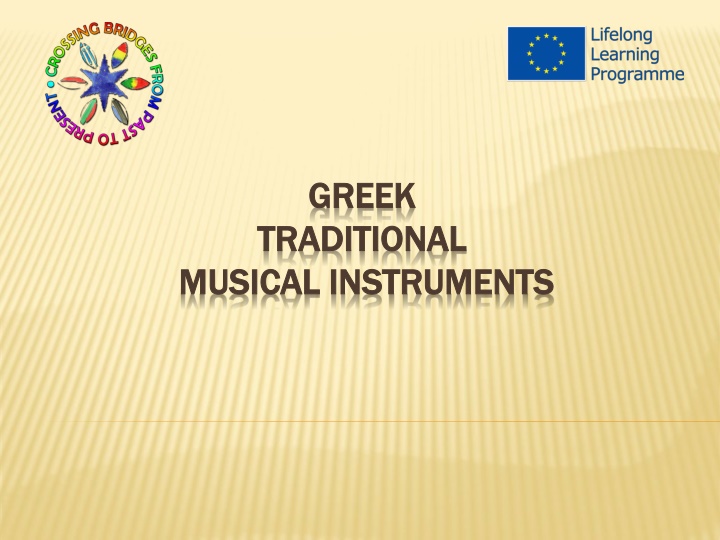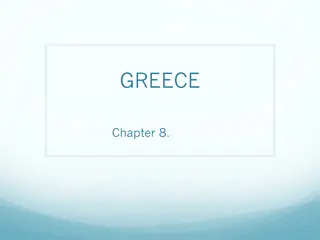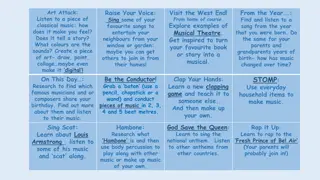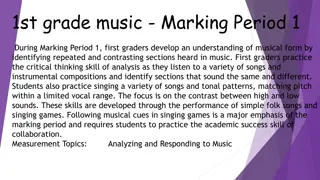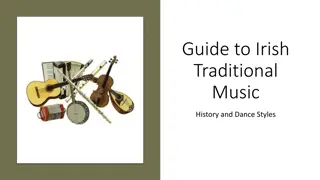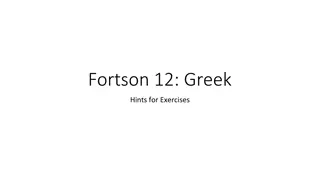Exploring Greek Traditional Musical Instruments
Greek music is rich in diversity, reflecting the influences of various civilizations on the country. Explore traditional Greek musical instruments like Zournas, Klarino, and Flogera, each with its unique history and significance in Greek folk music.
Download Presentation

Please find below an Image/Link to download the presentation.
The content on the website is provided AS IS for your information and personal use only. It may not be sold, licensed, or shared on other websites without obtaining consent from the author.If you encounter any issues during the download, it is possible that the publisher has removed the file from their server.
You are allowed to download the files provided on this website for personal or commercial use, subject to the condition that they are used lawfully. All files are the property of their respective owners.
The content on the website is provided AS IS for your information and personal use only. It may not be sold, licensed, or shared on other websites without obtaining consent from the author.
E N D
Presentation Transcript
GREEK GREEK TRADITIONAL TRADITIONAL MUSICAL INSTRUMENTS MUSICAL INSTRUMENTS
Greek music is a genre of music that is full of diversity, because Greece is one of the world s oldest civilizations. Therefore, there have been many different kinds of music. Greece is a country that has been heavily influenced by other civilizations, like European and the Asian cultures.That s why many of these instruments can be found in other countries.
Zournas Zournas or or Karamuza Karamuza Zournas is a type of Greek reed instrument, evolved from the ancient Greek musical instrument, avlos. It has 7 holes on its main body and one at the back . It is made of very hard wood or metal. Zournas Zournas in Macedonia in Macedonia (59 .) (59 .) and and Attica's karamouza karamouza (34 Attica's (34 .) .) Variations of these instrument could be found in the most regions from the North all the way to the South, and even on some of the islands. Other names for the zournas include: zournadi, pipiza and karamuza. It is made in different sizes from 22 to 60 cm long. The shorter one can be found in Peloponnesus and central Greece and the longest in Macedonia. It has an extremely loud sound, that s why it is an outdoor instrument and it's played together with "daouli" a percussion instrument. https://www.youtube.com/watch?v=dKx65JsYZAE https://www.youtube.com/watch?v=dKx65JsYZAE Daouli and Daouli and karamuza Yero Yero- -Brilis Brilis and and Karas ( (Yiorgis Yiorgis Vardouniotis Vardouniotis)., 1966. 1966. karamuza: : Karas ).,
Klarino Klarino- - Clarinet Clarinet The clarinet came as a folk instrument in Greece around the middle of 19th century. From Epirus and Western Macedonia was spread over the country. Klarino is what the Greeks call the Greek clarinet, and it is the most popular lead melody instrument in the mainland regions of Greece. It is an Albert (or simple) system clarinet which is an older, more primitive version of the clarinet and now is common in classical and popular music in the most regions of Europe and America. The Albert system klarino has fewer keys and has a different tone than the modern clarinet. The Greeks "klaritzides" also play the klarino with a different style and sound than that used by classical musicians in Europe and America. Klarino Klarino https:// www.youtube.com/watch?v=9b_5 https:// www.youtube.com/watch?v=9b_5- -Hletu4 Hletu4
Flogera Flogera- - Shepherd's flute Shepherd's flute gavali gavali The flogera is a type of flute used in Greek folk music. The flogera is the Greek shepherd's flute . It is not a "whistle" type flute where the musician puts the flute into his mouth and blows like blowing a whistle. Instead, the musican blows across the open end or rim of the upper part of the flogera. It typically has seven finger holes. It is found in different sizes from 50-85 cm and it typically has seven finger holes on its reed body. It's opened both sides of the reed. In order to be played it is holded at the right side. It can vary in length, but commonly the flogera is about 12 inches long, more or less. In northern Greece they also have longer flogeres. In Epirus, northwestern Greece, these longer flutes are called tzamara. In Greek Thrace, northeastern Greece, they are sometimes called gavali . The longer tzamara or gavali flutes have a different fingering and allow for playing half tones more easily than on the shorter floyera. https:// www.youtube.com/watch?v=AZI4q38lduY https:// www.youtube.com/watch?v=AZI4q38lduY Tzamara Tzamara F Flogera logera
Gaida Gaida- - Tsabouna Tsabouna " "Gaida Gaida" " " "Tsabouna Tsabouna Wind instrument of the bagpipe family . There are two types of Greek bagpipes. The one is called "Gaida" and it is played in Macedonia and Thrace and the other one is called "Tsabouna and it is played in the islands. The "bag" of the instrument is made of goat skin and they pipes are made of wood, reed or bone. https://www.youtube.com/watch?v=EZHp6mIoytY https://www.youtube.com/watch?v=EZHp6mIoytY
Daouli Daouli- -Toumbi Toumbi The daouli daouli is the two headed drum. The daouli player usually hangs the drum from a belt or strap over his left shoulder. The right side of the drum has a lower pitched skin, while the left side has a higher pitched skin. Goatskins are usually used for the drumheads. The toumbi toumbi is a very small drum made in a similar way to the daouli. It is mainly used on the Aegean islands like Kythnos. The toumbi is held usually under the left arm, and the head of the drum is struck with two drum sticks. It is often used to accompany the island tsabouna (bagpipe). The right or lower side is struck with the "daouloxylo" or daouli stick, and the left or higher pitched side is struck with the "daouloverga" or daouli switch. Other names for the daouli, depending on the area, include toumpano, tymbano, toumbi,daouli or davouli. https:// www.youtube.com/watch?v=dKx65JsYZAE https:// www.youtube.com/watch?v=dKx65JsYZAE These drums vary in size.
Touberleki Touberleki The touberleki , is a kind of a Greek traditional drum musical instrument. It is made from metal, it is open at its down side and it is covered with a skin stretched over it. It is played with the hands and used often in the Greek traditional folk rhythms, for the particularly cover of some special kinds of the Greek music.
Defi Defi- -Tambourine Tambourine The defi is a fairly large hand drum with metal bangles. It is similar to a tambourine in construction, however the defi is made with a metal screw system so that the head can be tightened and tuned. The defi is particularly popular in Epirus in northwestern Greece, where they are still handmade today. They have a beautiful low tone, and the bangles are low pitched as well. A virtuoso defi player can decorate the rhythm of the songs in many exciting ways.
Pontiac Lyre Pontiac Lyre The lyre of the Greeks of Pontos (Black Sea region of Asia Minor) is also known as the Kementse. It is played like a violin (violi) with a primitive style bow, but the musicians hold the lyre in an upright position. Sometimes they rest the instrument on their knee while they are sitting, and sometimes it is held out in front of them. They sometimes even dance in front of the dancers while holding the lyre in that way. The lyre usually has three strings. There are several tunings. The Pontiac music has a very unique sound. https:// www.youtube.com/watch?v=o1gP6K7yt4U https:// www.youtube.com/watch?v=o1gP6K7yt4U
Lyre Crete Lyre Crete The Cretan lyra is considered as the most popular surviving form of the medieval byzantine lyra and it is the most popular melody instrument on the island of Crete. It is a bowed instrument similar to the violin (violi), and it usually has three strings which are tuned in fifths. The lyra players play the lyra in an upright position. They sometimes rest it on their knee, or, if they are standing, they put one foot up on a chair and rest the lyra on the thigh. They have an unusual way of fingering the strings. Instead of pressing the strings with the finger tips (like violinists or guitarists do), they press against the sides of the strings with the tops of their finger nails. Several variations of Cretan Several variations of Cretan lyre museum Greek lyre museum Greek traditional instruments, traditional instruments, Athens. Athens. https://www.youtube.com/watch?v=3msf4kUQmcw https://www.youtube.com/watch?v=3msf4kUQmcw
Bouzouki Bouzouki- - Baglamas Baglamas- - Tzouras Tzouras The bouzouki is the main folk instrument found in the taverna style or rebetiki music of the seaports and urban areas of Greece. The bouzouki is the descendent of ancient Greek and eastern instruments. In ancient times the name of this long-necked string instrument was "trichordo" or "three stringed instrument. During the byzantine period, it had many names including "tambouras," "yiongari," "pantouri," and others. The make up of the typical bouzouki musical group has varied and changed over the years and has included many types of instrument groupings. A very common musical group might be one or two bouzoukia, a baglamas, and a kithara (guitar). Sometimes a violin, or an accordion, a piano, or other instruments would be played as well. Similar instruments that are played like the bouzouki in this style of music are the tzouras (long necked, like the bouzouki, but with a smaller body), and the baglamas (a very small bouzouki). bouzouki bouzouki baglamas baglamas https://www.youtube.com/ https://www.youtube.com/ watch?v=pXdpM5IzM6c watch?v=pXdpM5IzM6c tzouras tzouras
Kanonaki Kanonaki Kanonaki is a triangle shaped instrument and is tuned according to the chromatic scale. It has 72 plastic strings that produce 24 notes each. The most common type of kanonaki is played with two springs that fit to the index fingers of both hands. According to the historians, the Greek mathematician Pythagoras was trying to determine the different notes of the ancient form of the instrument, based on the thickness and length of the strings. Kanonaki is considered one of the oldest Greek music instruments and today there are very few kanonaki players. https://youtu.be/s_uX8lijB https://youtu.be/s_uX8lijB- -c c https://www.youtube.com/watch?v=IbKV8jLDFIk https://www.youtube.com/watch?v=IbKV8jLDFIk
Santouri Santouri www.youtube.com/watch?v=EcQ0_pCSDfw www.youtube.com/watch?v=EcQ0_pCSDfw Santouri is a traditional Greek music instrument, the most modern version of the ancient Epigonio and Psalterion. Santouri derives from the persian name "santir" and it is a trapezoid shaped instrument with a small sound box. Santouri has 120-140 strings and produce 32 notes. They are made of steel while the bass strings are made of copper. Few players of santouri exist today in Greece.
Sites Sites : http://www.helleniccomserve.com/stringintruments.htm http://www.greekfolkmusicanddance.com/instruments.php https://en.wikipedia.org/.../greek_musical https://el.wikipedia.org/wiki/ : _ _ http://www.instruments-museum.gr http://www.greeksongs-greekmusic.com/traditional-stringed-instruments-in-greek- music/ http://music-archive.aegean.gr/ http://www.pmglp.org/index.php/el/musikis/musorg/paradosiaka?showall=1&limitst art=
This project has been funded with This project has been funded with support from the European Commission. support from the European Commission. This publication reflects the views only of This publication reflects the views only of the author, and the Commission cannot the author, and the Commission cannot be held responsible for any use which be held responsible for any use which may be made of the information may be made of the information contained therein. contained therein.
